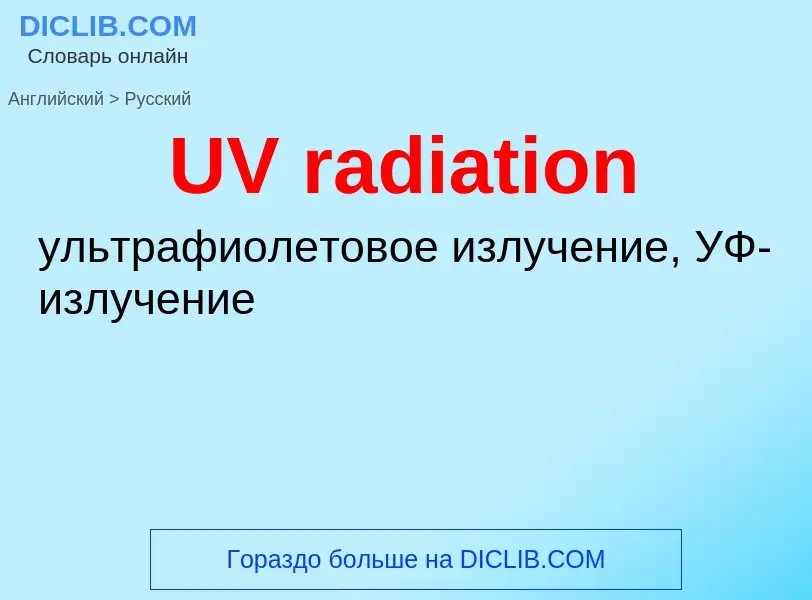Tradução e análise de palavras por inteligência artificial ChatGPT
Nesta página você pode obter uma análise detalhada de uma palavra ou frase, produzida usando a melhor tecnologia de inteligência artificial até o momento:
- como a palavra é usada
- frequência de uso
- é usado com mais frequência na fala oral ou escrita
- opções de tradução de palavras
- exemplos de uso (várias frases com tradução)
- etimologia
UV radiation - tradução para russo
[ʌltrə'vaiəlit]
общая лексика
ультрафиолетовый
UV
ультрафиолетовый свет
часть электромагнитного спектра, лежащая за фиолетовым цветом видимой части спектра. Используется, в частности, для стирания ППЗУ
МУФ
медицина
ультрафиолет
прилагательное
физика
ультрафиолетовый (о лучах)
существительное
[ʌltrə'vaiəlit]
оптика
ультрафиолет
ультрафиолетовая область излучения
Definição
Wikipédia

Ultraviolet (UV) is a form of electromagnetic radiation with wavelength shorter than that of visible light, but longer than X-rays. UV radiation is present in sunlight, and constitutes about 10% of the total electromagnetic radiation output from the Sun. It is also produced by electric arcs, Cherenkov radiation, and specialized lights, such as mercury-vapor lamps, tanning lamps, and black lights. Although long-wavelength ultraviolet is not considered an ionizing radiation because its photons lack the energy to ionize atoms, it can cause chemical reactions and causes many substances to glow or fluoresce. Many practical applications, including chemical and biological effects, derive from the way that UV radiation can interact with organic molecules. These interactions can involve absorption or adjusting energy states in molecules, but do not necessarily involve heating.
Short-wave ultraviolet light damages DNA and sterilizes surfaces with which it comes into contact. For humans, suntan and sunburn are familiar effects of exposure of the skin to UV light, along with an increased risk of skin cancer. The amount of UV light produced by the Sun means that the Earth would not be able to sustain life on dry land if most of that light were not filtered out by the atmosphere. More energetic, shorter-wavelength "extreme" UV below 121 nm ionizes air so strongly that it is absorbed before it reaches the ground. However, ultraviolet light (specifically, UVB) is also responsible for the formation of vitamin D in most land vertebrates, including humans. The UV spectrum, thus, has effects both beneficial and harmful to life.
The lower wavelength limit of human vision is conventionally taken as 400 nm, so ultraviolet rays are invisible to humans, although people can sometimes perceive light at shorter wavelengths than this. Insects, birds, and some mammals can see near-UV (NUV) (i.e., slightly shorter wavelengths than what humans can see).


![UV damaged [[polypropylene]] rope (left) and new rope (right) UV damaged [[polypropylene]] rope (left) and new rope (right)](https://commons.wikimedia.org/wiki/Special:FilePath/Failedrope1.jpg?width=200)

![IR spectrum showing carbonyl absorption due to UV degradation of [[polyethylene]] IR spectrum showing carbonyl absorption due to UV degradation of [[polyethylene]]](https://commons.wikimedia.org/wiki/Special:FilePath/Irspec2.jpg?width=200)
![Aurora at [[Jupiter]]'s north pole as seen in ultraviolet light by the [[Hubble Space Telescope]]. Aurora at [[Jupiter]]'s north pole as seen in ultraviolet light by the [[Hubble Space Telescope]].](https://commons.wikimedia.org/wiki/Special:FilePath/Jupiter.Aurora.HST.UV.jpg?width=200)






![After a training exercise involving fake [[body fluids]], a healthcare worker's [[personal protective equipment]] is checked with ultraviolet light to find invisible drops of fluids. These fluids could contain deadly viruses or other contamination. After a training exercise involving fake [[body fluids]], a healthcare worker's [[personal protective equipment]] is checked with ultraviolet light to find invisible drops of fluids. These fluids could contain deadly viruses or other contamination.](https://commons.wikimedia.org/wiki/Special:FilePath/Ultra-violet screening for potentially Ebola-carrying liquids (15811190376).jpg?width=200)
